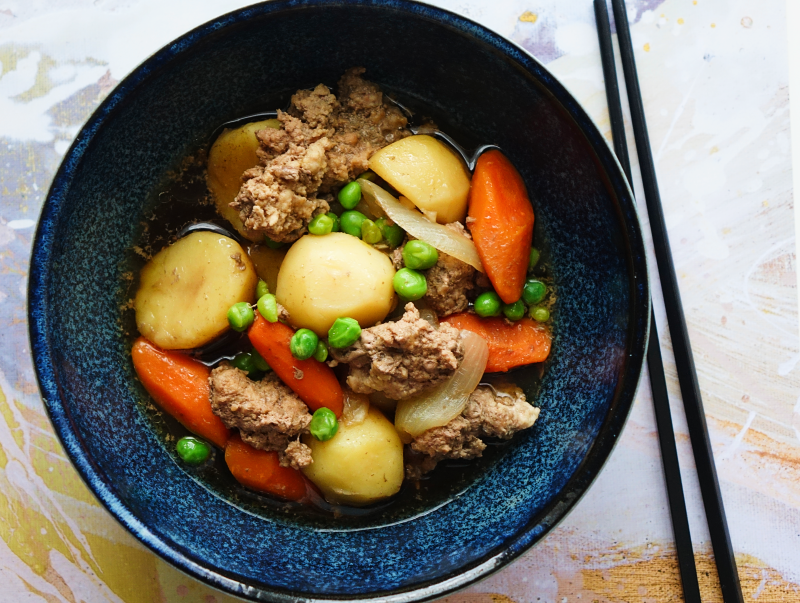Discover the comforting and savory-sweet flavors of Japanese Beef and Potato Stew or Nikujaga, a classic Japanese beef stew that embodies the essence of Japanese comfort food. This easy stew recipe is a staple of Japanese cuisine, perfect for a cozy weeknight dinner, especially during the colder months. This one-pot meal features tender beef, melt-in-your-mouth potatoes, and vibrant vegetables simmered in a rich, flavorful broth. Whether you’re looking for easy Japanese recipes, beef and potato recipes, or a delicious and healthy Japanese recipe, this Nikujaga recipe will surely satisfy you. In some regions, Nikujaga, also known as beef and potato stew, is a beloved dish in Japanese recipes and stew recipe collections. It’s a testament to the simplicity and deliciousness of combining potato and beef recipes in one satisfying meal. If you’re new to Japanese cuisine, this easy stew recipe is a fantastic place to start your culinary journey. It’s a perfect example of how Japanese comfort food can be flavorful and nourishing.
- Three big potatoes
- One carrot
- One onion
-
One cup of green peas (fresh or frozen)
-
300 grams of minced beef or veal
-
Three tbsp. of soy sauce
-
Three tbsp. of Teriyaki sauce
-
Two tbsp. of cooking vine or white vine
- Chef’s Knife: Cutting
- Cutting Board: Cutting surface
- Large Pan/Pot: Stovetop cooking
- Spoon/Spatula: Stirring/Mixing
- Measuring Spoons: Small measures
- Measuring Cups: Larger measures
- Colander/Strainer: Draining
- Bowl: Holding/Mixing
- Prepare the Vegetables: Peel and cube the potatoes. Soak them in water for 5 minutes to prevent browning, then drain. This step is essential for achieving the right texture in your Nikujaga. Peel and slice the carrot. Peel and cut the onion into wedges.
- Brown the Beef: In a large pot or Dutch oven, brown the minced beef over medium-high heat. If you use lean meat for your Nikujaga, you may need to add a little cooking oil. Break up any large clumps of meat. Remove the beef from the pot and set aside. (Draining excess fat is optional for a healthier Nikujaga.)
- Sauté the Vegetables: In the same pot, sauté the onions until translucent. Add the carrots and potatoes and stir for a few minutes.
- Add Flavor: Return the browned beef to the pot. Add the soy sauce, teriyaki sauce, sake (or vinegar), and sugar (if using). Stir to coat all ingredients.
- Simmer the Stew: Add enough water just to cover the ingredients. Bring to a boil, then reduce to a simmer. Cover and cook for about 20-25 minutes or until the vegetables are tender. Check occasionally and add more water if needed. This slow simmering is key for a rich, flavorful Nikujaga.
- Add Peas: Add the green peas during the last 5 minutes of cooking. If using frozen peas, there’s no need to thaw them first.
- Season to Taste: Taste the stew and adjust the seasoning as needed. Add more soy sauce or teriyaki sauce for a saltier flavor, or a pinch of sugar for more sweetness.
- Serve the Nikujaga hot, traditionally with a bowl of steamed rice and perhaps a side of miso soup and Japanese pickles, which is the classic way to enjoy this comforting Japanese dish.
- Flavor Balance: The key to delicious Nikujaga is balancing the savory soy sauce and the sweetness of the teriyaki sauce and vegetables. Adjust the flavors to your preference.
- Don’t Overcook: Be careful not to overcook the vegetables, especially the potatoes. They should be tender but still hold their shape.
- Make Ahead: Nikujaga tastes even better the next day as the flavors meld together. To make it a great make-ahead meal, store leftovers in an airtight container in the refrigerator.
- Meat Options: This dish can be made with beef, pork, or chicken. Thinly sliced beef is often preferred. For an authentic Nikujaga
- Vegetarian Version: For a vegetarian version, substitute firm tofu or other alternatives for the meat. Add more vegetables, such as mushrooms or yam noodles.
- Presentation: Garnish with chopped green onions or sesame seeds for an extra touch.
Nikujaga is often served with rice, miso soup, and other side dishes, such as grilled items. Salted pickles can complement this dish.
The history of Nikujaga dates back to Japan’s admiral Tōgō Heihachirō, who requested his cooks to replicate the beef stew he had enjoyed during his travels, leading to the creation of this dish.

